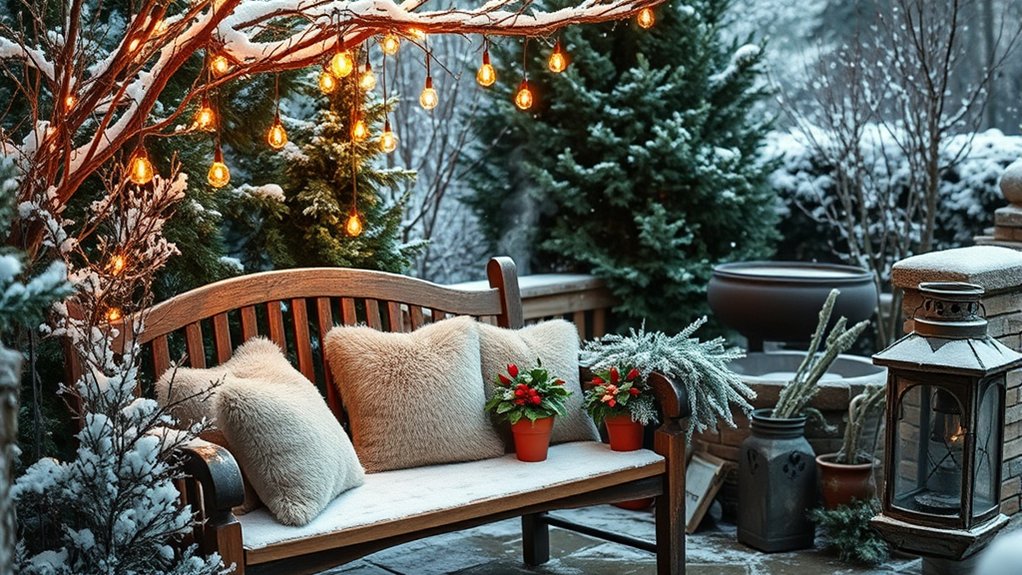I love adding evergreen shrubs like boxwood or juniper to keep structure and color in winter, then planting cheerful bulbs such as snowdrops and crocuses for early blooms. Incorporating ornamental grasses gives texture, while a cozy seating area with heaters invites you out in cold weather. Don’t forget lanterns and solar lights to brighten paths, plus bird feeders for wildlife visits. Layering mulch, bark, and stones adds warmth and visual interest. If you want to craft a vibrant winter garden, keep exploring these ideas.
- Key Takeaways
- Add Evergreen Shrubs and Hedges
- Plant Colorful Winter-Flowering Bulbs
- Incorporate Ornamental Grasses
- Create a Cozy Seating Area with Heaters
- Use Lanterns and Solar Lights
- Decorate with Colorful Pots and Containers
- Install a Fire Pit or Outdoor Fireplace
- Set Up Covered Pergolas or Canopies
- Hang Bird Feeders for Wildlife
- Grow Frost-Hardy Herbs and Veggies
- Add Reflective Elements like Mirrors
- Layer Textures with Mulch, Bark, and Stones
Key Takeaways
- Incorporate evergreen plants like Boxwood and Dwarf Alberta Spruce for year-round structure and visual interest in your winter garden.
- Plant winter-flowering bulbs such as snowdrops and crocuses in fall to brighten the garden and attract early pollinators.
- Create cozy outdoor seating areas with weather-resistant furniture, heaters, and soft textiles for comfortable winter enjoyment.
- Use bird feeders stocked with high-energy seeds and frost-hardy herbs to attract and support winter wildlife.
- Enhance your garden with mulch, bark, and stone to retain moisture, suppress weeds, add texture, and define paths effectively.
Add Evergreen Shrubs and Hedges
Even though winter can leave many gardens looking bare and dull, adding evergreen shrubs and hedges can completely transform your outdoor space into a vibrant, year-round retreat.
I’ve found that mixing evergreen varieties like Boxwood, Juniper, and Dwarf Alberta Spruce creates structure and interest when other plants sleep through winter.
Using potted evergreens lets me easily refresh seasonal arrangements, moving them around for fresh looks without much effort.
By combining different heights and textures, your garden stays lively and inviting all season long.
It’s a simple way to feel connected with nature, even in the coldest months.
Plant Colorful Winter-Flowering Bulbs
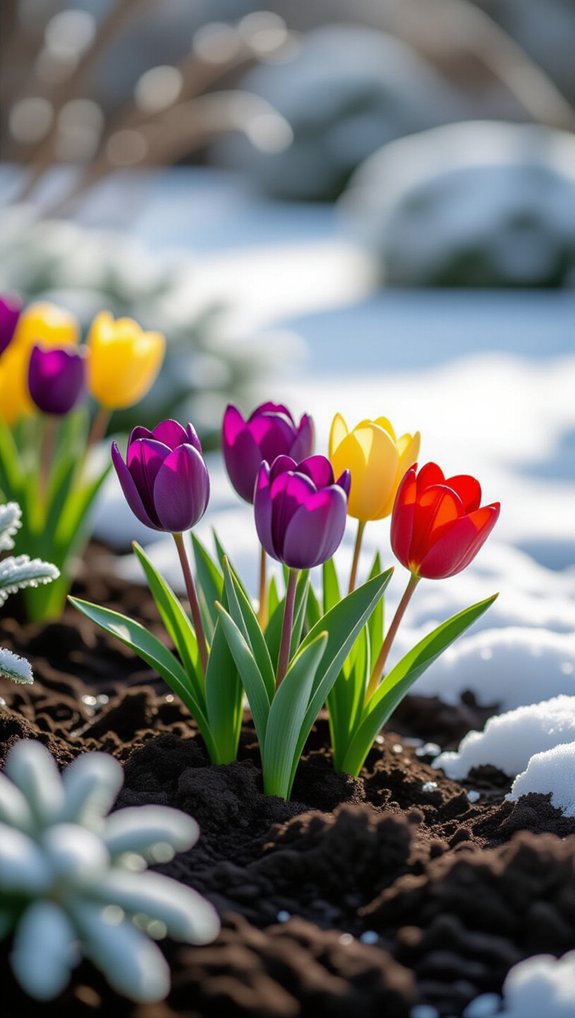
Although winter often leaves gardens looking gray and lifeless, planting colorful winter-flowering bulbs can bring a much-needed splash of cheer to your outdoor space.
I love choosing bulb varieties like snowdrops, crocuses, and winter aconites because they bloom early, brightening dull days.
To get the best results, I follow simple planting techniques: plant bulbs in well-drained soil about three times their height in depth during fall. This helps them establish roots before winter.
Plus, these bulbs attract early pollinators, inviting life back into the garden. Together, these tips create vibrant, joyful patches that celebrate winter’s charm.
Incorporate Ornamental Grasses
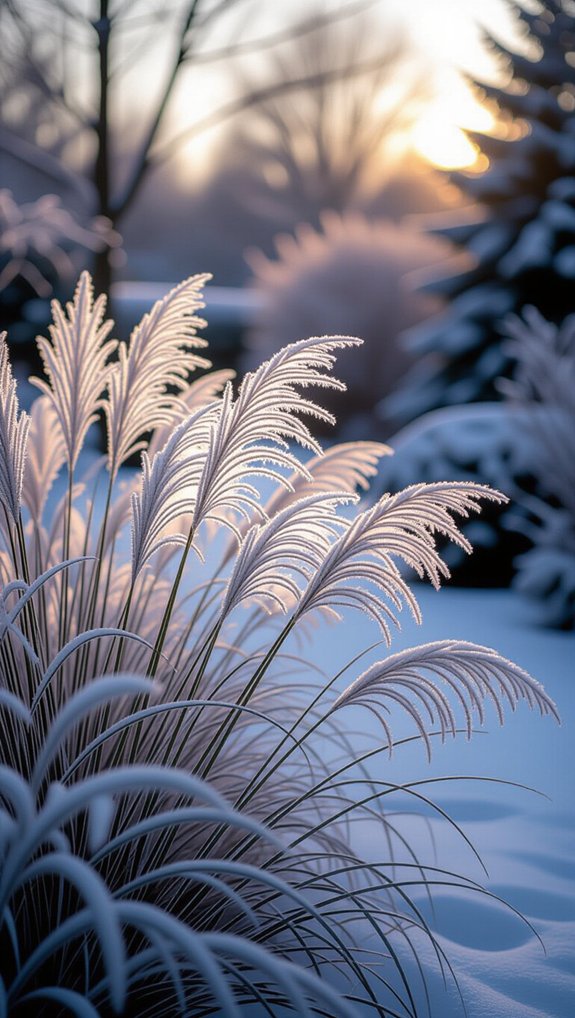
When you add ornamental grasses to your winter garden, you instantly bring texture and movement that brighten up even the dullest days.
I love mixing grass varieties like Miscanthus and Calamagrostis because their seed heads catch light beautifully, adding sparkle to snowy scenes. Plus, they stand tall when other plants rest, giving structure and warmth.
Don’t forget grasses like Carex, which stay green longer, creating year-round interest. Best of all, these grasses invite wildlife attraction—birds feast on their seeds during winter, making your garden a lively, welcoming place even in the coldest months.
Give it a try!
Create a Cozy Seating Area with Heaters

Since chilly weather can quickly send us indoors, I’ve found that creating a cozy seating area with heaters transforms your winter garden into a welcoming retreat you’ll want to use all season long.
Start by choosing weather-resistant seating styles like cushioned benches or wicker chairs, which feel inviting even when it’s cold.
Then, investigate heating options such as electric or propane heaters to keep the space warm.
Adding soft blankets and cushions not only boosts comfort but also adds color.
Don’t forget windbreaks like trellises with plants to shield you from cold gusts while still enjoying your garden’s view.
Use Lanterns and Solar Lights

Even as daylight fades earlier in winter, you can keep your garden glowing warmly by using lanterns and solar lights.
Choosing varied lantern styles adds charm and lets you play with light patterns, especially with colored or patterned glass.
Solar placement is key—spot them along paths, near trees, or by garden highlights to brighten and beautify.
Here’s what I suggest:
- Mix lantern sizes for depth and interest
- Use solar lights for eco-friendly, automatic glow
- Place lights to highlight winter plants
- Opt for lanterns with colored glass to cast magical shadows
This creates a cozy, inviting winter garden you’ll love.
Decorate with Colorful Pots and Containers

Although winter often brings a quieter palette to the garden, adding colorful pots and containers can instantly brighten up the space and lift your spirits. I love mixing container shapes and using color psychology to choose pots—reds energize, blues calm, and yellows cheer. Evergreen plants like Soft Serve False Cypress add year-round charm. Moving large pots lets me highlight different spots, creating a cozy vibe. Here’s a simple guide to evoke warmth:
| Emotion | Pot Color | Container Shape |
|---|---|---|
| Cheerfulness | Yellow | Round |
| Calmness | Blue | Square |
| Energy | Red | Tall |
Try it—I promise it feels like a warm hug!
Install a Fire Pit or Outdoor Fireplace
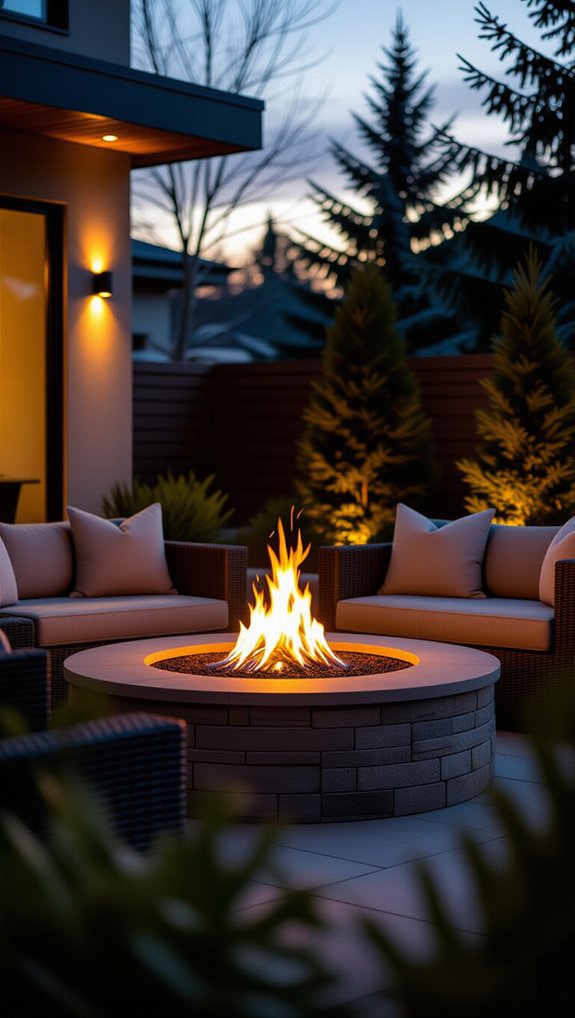
When you add a fire pit or outdoor fireplace to your winter garden, you open up a whole new world of cozy gatherings and warm memories.
Choosing the right fire pit materials—stone, brick, or metal—lets you match your style and budget perfectly.
Don’t forget these safety considerations to keep everyone safe:
- Place the fire pit on a non-flammable surface
- Keep it away from structures and overhanging trees
- Regularly clean out ash and debris
- Arrange comfy seating nearby to invite conversation
This setup extends outdoor fun and creates a welcoming space for friends and family all winter long.
Set Up Covered Pergolas or Canopies

Since winter weather can be unpredictable, setting up a covered pergola or canopy is a smart way to keep your outdoor space cozy and usable all season long.
I’ve found that choosing the right pergola materials—like sturdy wood or weatherproof metal—makes a big difference in durability and style.
Adding climbing evergreens not only looks inviting but also boosts winter insulation, trapping warmth underneath.
Don’t forget to plan for proper drainage and snow load so your structure stays safe.
With a little care, your covered pergola becomes a warm, welcoming spot to enjoy crisp winter days together.
Hang Bird Feeders for Wildlife
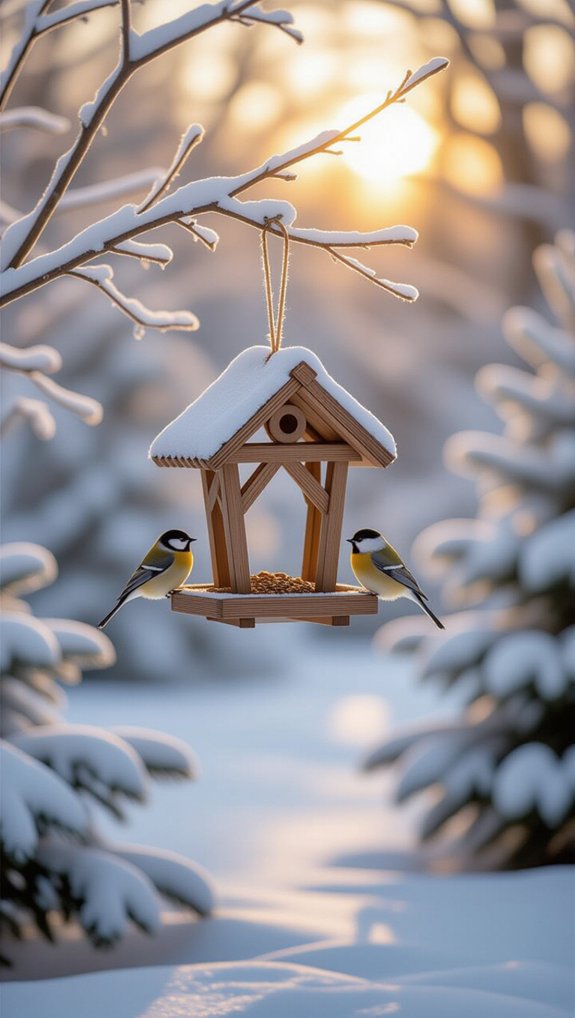
Bringing a cozy covered pergola into your winter garden sets a lovely scene, but adding bird feeders can really bring your outdoor space to life with fluttering visitors.
Choosing the right bird feeder types and seed selection is key to attracting a variety of birds. Here’s what I’ve learned:
- Use tube feeders for small birds and platform feeders for larger ones.
- Pick high-energy mixes with black oil sunflower seeds.
- Hang feeders near evergreens for shelter.
- Clean and refill feeders regularly to keep birds coming back.
These simple steps create a welcoming winter haven for wildlife—and for you!
Grow Frost-Hardy Herbs and Veggies

Although winter might seem like a dormant time for gardens, you can actually grow a surprising variety of frost-hardy herbs and veggies that not only survive but often taste better after a touch of frost. Using frost hardy varieties and smart winter gardening techniques, I protect my plants with row covers and water them well before freezes. Here’s a quick guide to get you started:
| Frost-Hardy Herbs | Frost-Hardy Veggies |
|---|---|
| Parsley | Kale |
| Chives | Swiss chard |
| Thyme | Garlic (planted late fall) |
Give these a try, and join me in extending the growing season!
Add Reflective Elements like Mirrors

When winter’s shorter days leave your garden feeling a bit dim and cramped, adding mirrors can brighten things up and create a lovely sense of space.
Thoughtful mirror placement lets reflective surfaces bounce natural light around, making your garden feel larger and more inviting. Here’s how I do it:
- Choose weather-resistant mirrors for durability.
- Position mirrors near evergreens or snowy spots to reflect nature’s beauty.
- Frame mirrors with climbing plants for a cozy, natural look.
- Place mirrors by paths or seating areas to invite guests to investigate different views.
Reflective elements truly warm up winter’s chill.
Layer Textures with Mulch, Bark, and Stones

Since winter gardens often lose their colorful blooms, I love to layer different textures like mulch, bark, and stones to keep things interesting and inviting.
Using texture combinations like soft mulch, fragrant cedar bark, and smooth stones creates seasonal contrasts that brighten the colder months.
Mulch warms the soil and enriches it as it breaks down, while bark helps retain moisture and keeps weeds away.
Stones add structure, defining paths or borders with varied sizes and colors.
Together, these layers bring depth and warmth, making your winter garden feel cozy and alive, even without flowers.


